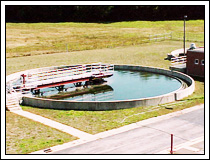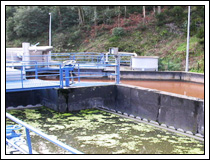Secondary Sewage Treatment
After primary treatment processes, the sewage water is passed forward for the Secondary treatment phase. Ideally, this entire phase is carried out in the  activated sludge component of the treatment plant, which is also known as the aeration tank. The aeration tank is a zone, where the biological content of the sewage are degraded using biological processes, which subsequently reduces the BOD (Biochemical Oxygen Demand). The contents of the aeration tanks are commonly referred as the mixed liquor suspended solids (MLSS) or activated sludge. The activated sludge converts the organic pollutants of sewage into oxidized products which settle down on the secondary clarifiers. The entire process consists of various stages of decomposition, where the microorganisms and waste water are mixed, aerated, and maintained in suspension. Raw sewage can be introduced in various locations and be aerated and mixed for varying lengths of time and intensity. activated sludge component of the treatment plant, which is also known as the aeration tank. The aeration tank is a zone, where the biological content of the sewage are degraded using biological processes, which subsequently reduces the BOD (Biochemical Oxygen Demand). The contents of the aeration tanks are commonly referred as the mixed liquor suspended solids (MLSS) or activated sludge. The activated sludge converts the organic pollutants of sewage into oxidized products which settle down on the secondary clarifiers. The entire process consists of various stages of decomposition, where the microorganisms and waste water are mixed, aerated, and maintained in suspension. Raw sewage can be introduced in various locations and be aerated and mixed for varying lengths of time and intensity.
The Mechanism of the Secondary Sewage Treatment Process
The secondary treatment induces and accelerates the growth of aerobic heterotrophic bacteria, fungi and protozoa in the sewage, such that they break down the dissolved organic and other biological component of the sewage. The growth of these microorganisms incorporate new microbial cells (biomass) into the organic compounds of sewage, as a result of which, they settle out as suspensions, called sludge. It extremely crucial to keep the whole system or the tank highly aerated for the microorganisms to carry out the degradation process.
First Phase of the Secondary Treatment
During the first phase of secondary sewage treatment, the sewage is transferred to aerobic digesters where high level of dissolved oxygen is maintained using large pumps. In this bed of oxygen the sewage is continually circulated through trickle filters housed in "biotowers" or "activated growth units". These activated growth units are stacked with redwood slats which act as substrates for the attachment and growth of layers of aerobic or heterotrophic microorganisms. To enhance aerobic conditions, the liquid sewage is sprayed over the slats. Gradually, the organic compounds are broken down as the sewage trickles past the microbes growing on the slats. After the biological degradation of the microbes, the clarified water portion of the sewage is sent back to the aeration tank. It runs through the tower and re-enters the aeration tank from where it is circulated back through the towers for further clarification. Eventually, the microbial populations in the aeration tank increases; which can be seen from the appearance of foam on the surface. With the increased number of microbiological compounds, the cells of the biological compounds in the sewage begin to clump together to form (activated) sludge which settles out of the suspension.
Second Phase of the Secondary Treatment

After this, starts the second phase of secondary treatment which is carried out in post-secondary sedimentation tanks. The clarified water, also called clarified effluent sometimes, is passed to the post-secondary sedimentation tanks where it is allowed to settle once again. Once the desired settlement is obtained, the surface of the tank is slowly swept by a skimmer to remove surface growth on residual organics, which makes a part of the suspended sludge to collect at the bottom. The sludge collected from each of the sedimentation basins are combined and treated by anaerobic digestion processes in the anaerobic digesters. These digesters are heated to 35-38C to maintain a diverse community of bacteria at densities of 109 to1010 cells per ml. Here the microorganisms break down complex organic compounds of the collected sludge into methane or "natural" gas. This gas is collected in a large inflatable structure where they are further combined with commercial methane and employed to heat the digesters.
|